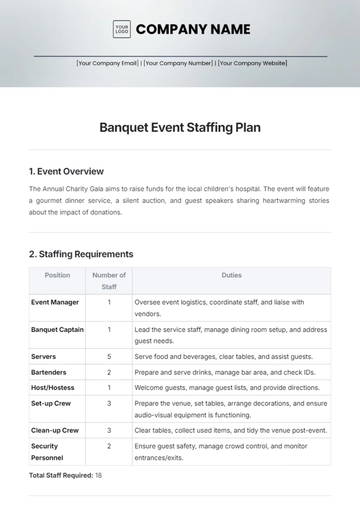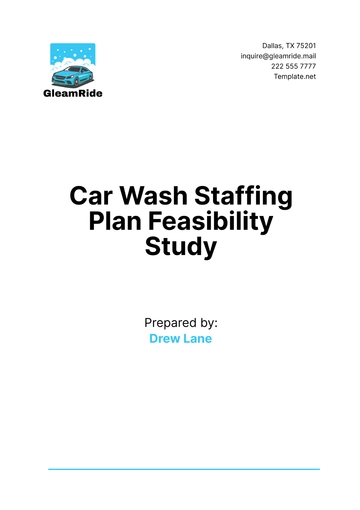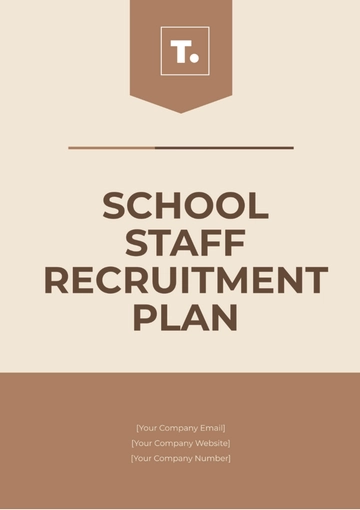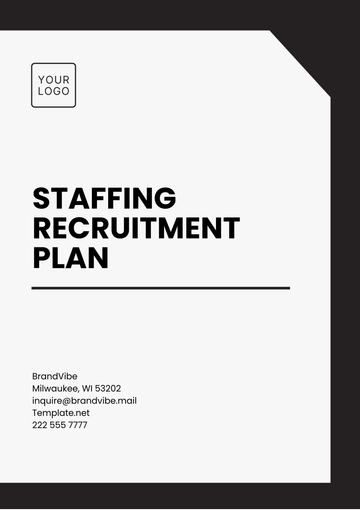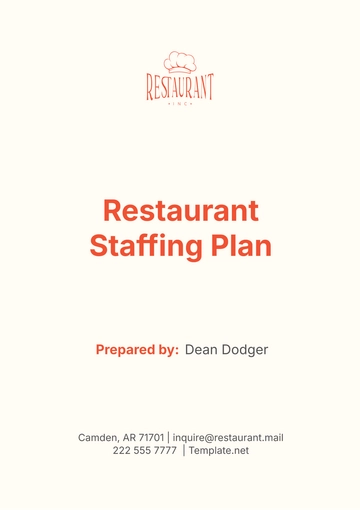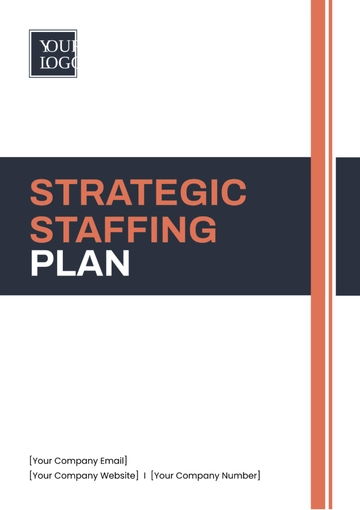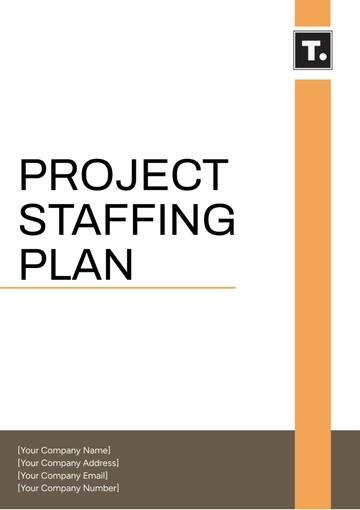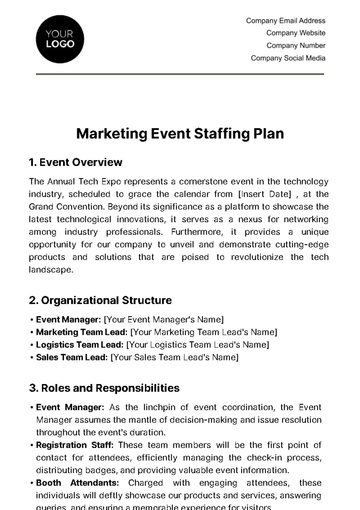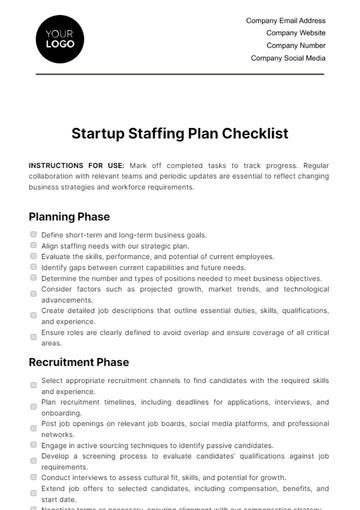Free Restaurant Staffing Plan

Introduction
Effective staffing is fundamental to the success of any restaurant. At [Your Company Name], our mission is to create a world-class dining experience by combining impeccable service with exceptional cuisine. This Restaurant Staffing Plan outlines our strategy to build and maintain a capable and dedicated team. By addressing current workforce needs, planning for future growth, and emphasizing employee development, we aim to enhance our operational efficiency and reinforce our reputation for excellence. This plan provides a comprehensive overview of our staffing requirements, recruitment strategies, training programs, and succession initiatives, ensuring that we are well-prepared to meet the dynamic demands of the restaurant industry.
1. Executive Summary
The primary objective of [Your Company Name] is to create a world-class dining experience that combines impeccable service with exceptional cuisine. To achieve this, we need a capable and dedicated team. This staffing plan aims to address our current workforce needs and prepare us for future growth. Through strategic recruitment, targeted training, and a focus on employee development, we will build a team that enhances the restaurant's reputation and operational efficiency.
2. Current Workforce Overview
This section provides a detailed overview of our existing workforce, highlighting current staffing levels and identifying gaps that need to be addressed. Understanding our present situation is crucial for making informed decisions about future staffing needs and ensuring that our team can meet the demands of a growing customer base.
Current Staff Overview
Department | Number of Employees | Key Roles |
|---|---|---|
Kitchen | 10 | Chefs, Line Cooks |
Front of House | 10 | Waitstaff, Hosts |
Management | 3 | General Manager, Shift Managers |
Support Staff | 2 | Cleaning, Maintenance |
Gaps Identified
Kitchen Staff: Insufficient number of kitchen staff during peak hours, leading to delays in service.
Waitstaff: Need for more experienced waitstaff to improve customer service quality.
Management: Inadequate coverage for managerial roles, impacting operational oversight and employee supervision.
3. Future Staffing Needs
In anticipation of future growth, this section outlines our projected staffing requirements. By identifying specific roles and the number of additional staff needed, we can proactively address potential challenges and ensure that our restaurant is well-equipped to provide exceptional service at all times.
Projected Workforce Needs
Role | Additional Staff Needed | Rationale |
|---|---|---|
Line Cooks | 5 | To meet increased customer demand and reduce wait times |
Experienced Waitstaff | 5 | To enhance customer service quality and manage peak times |
Assistant Manager | 1 | To support daily operations and oversee staff during shifts |
Justification for Future Needs
Line Cooks: As customer demand grows, additional line cooks are necessary to maintain timely service and uphold our culinary standards.
Experienced Waitstaff: Enhanced customer service is critical for maintaining and improving our dining experience, especially during busy periods.
Assistant Manager: Additional managerial support will ensure smooth operations, effective staff management, and adherence to health and safety standards.
4. Job Roles, Qualifications, and Responsibilities
Clearly defining job roles, qualifications, and responsibilities is essential for effective recruitment and employee performance. This section provides detailed descriptions for key positions within our restaurant, ensuring that each role is well understood and appropriately filled.
Line Cook
Qualifications:
Culinary school degree or equivalent experience
Strong understanding of food safety and sanitation practices
Responsibilities:
Prepare food items according to recipes and standards
Maintain kitchen cleanliness and organization
Manage inventory and restock supplies as needed
Waitstaff
Qualifications:
Prior restaurant experience
Excellent customer service and communication skills
Responsibilities:
Take orders and serve food and beverages
Handle customer inquiries and complaints professionally
Ensure dining area is clean and welcoming
Assistant Manager
Qualifications:
Bachelor's degree in hospitality management or related field
Managerial experience in a restaurant setting
Responsibilities:
Supervise staff and ensure efficient operation during shifts
Manage inventory and place orders for supplies
Ensure adherence to health and safety standards
5. Recruitment Strategies
Effective recruitment strategies are vital for attracting qualified candidates who align with our restaurant’s values and goals. This section outlines the methods we will use to find and hire the best talent, ensuring a strong and capable workforce.
Comprehensive Recruitment Approach
Strategy | Description | Targeted Roles |
|---|---|---|
Job Boards | Post job openings on popular job boards such as Indeed and Glassdoor | All roles |
Social Media Platforms | Utilize platforms like LinkedIn, Facebook, and Instagram to reach potential candidates | All roles |
Culinary School Partnerships | Partner with culinary schools for internship and job placement opportunities | Line Cooks |
Employee Referral Program | Offer referral bonuses to current employees who recommend successful hires | All roles |
Implementation Steps
Job Posting and Advertisement: Create compelling job postings highlighting our restaurant's unique culture and opportunities for growth.
Screening and Interviews: Conduct thorough screening and multiple rounds of interviews to ensure candidates meet our standards.
Hiring and Onboarding: Offer competitive packages and conduct comprehensive onboarding programs to integrate new hires effectively.
6. Training Plans
To maintain high standards and continuous improvement, it is crucial to invest in regular training for our staff. This section details our training programs, which are designed to enhance skills, ensure compliance, and foster professional development.
Structured Training Programs
Training Type | Frequency | Target Audience | Objectives |
|---|---|---|---|
Onboarding Program | Initial hire | New employees | Familiarize new hires with procedures and culture |
Customer Service Training | Quarterly | Waitstaff | Improve customer service skills and handling difficult situations |
Food Safety Training | Bi-annual | Kitchen staff | Ensure compliance with health regulations and food safety practices |
Leadership Development | Semi-annual | Potential leaders | Develop management skills and leadership qualities |
Advanced Skills Workshops | Monthly | All staff | Enhance specialized skills and professional development |
Training Implementation
Onboarding: Conducted during the first week of employment, covering company culture, job-specific training, and health and safety procedures.
Regular Training Sessions: Ongoing sessions focused on key skills and compliance requirements, ensuring continuous improvement and up-to-date knowledge.
Development Workshops: Interactive workshops and seminars designed to develop leadership and advanced skills among employees.
7. Succession Initiatives
Succession planning is vital for ensuring long-term stability and leadership continuity. This section outlines our initiatives to identify and develop high-potential employees for future leadership roles, ensuring that we have a strong pipeline of talent.
Succession Planning Framework
Initiative | Description | Target Audience |
|---|---|---|
High-Potential Identification | Identify employees with potential for leadership roles | All staff |
Mentorship Programs | Experienced managers mentor high-potential employees | Identified high-potential staff |
Career Progression Pathways | Clear career paths and development opportunities | All staff |
Succession Planning Steps
Identify Potential Leaders: Use performance reviews and feedback to identify employees with leadership potential.
Mentorship Programs: Pair high-potential employees with experienced managers for guidance and development.
Career Progression: Outline clear career paths with opportunities for advancement and additional responsibilities.
8. Budget Estimates and Timeline
A well-planned budget and timeline are essential for implementing our staffing plan effectively. This section provides detailed budget estimates and a timeline for recruitment, training, and succession planning activities.
Staffing Budget Overview
Item | Cost | Timeframe |
|---|---|---|
Recruitment | $5,000 | 1-3 months |
Training Programs | $8,000 | Ongoing |
Succession Planning | $3,000 | 6-12 months |
Budget Details
Recruitment: Costs include job postings, advertising, and recruitment agency fees if applicable.
Training Programs: Costs cover materials, trainers, and any external courses or workshops.
Succession Planning: Costs include mentorship programs, leadership training, and career development resources.
Timeline for Implementation
Phase | Description | Timeframe |
|---|---|---|
Recruitment | Initial hiring and onboarding | Months 1-3 |
Training Programs | Continuous skill development and compliance training | Ongoing |
Succession Planning | Identify and develop future leaders | Months 6-12 |
9. Recommendation
To ensure [Your Company Name] continues to thrive and achieve its organizational goals, it is essential to implement this comprehensive staffing plan. By strategically addressing current gaps and anticipating future needs, we will enhance our operational efficiency and create an exceptional dining experience for our customers.
Key Actions
Immediate Recruitment: Fill current staffing gaps to ensure operational efficiency.
Ongoing Training: Implement regular training programs to maintain high standards and develop employee skills.
Future Planning: Establish succession initiatives to ensure long-term leadership and organizational stability.
Benefits
Improved Service Quality: Enhanced training and additional staff will lead to better customer service and satisfaction.
Operational Efficiency: Adequate staffing ensures smooth operations, especially during peak hours.
Employee Development: Clear career paths and development opportunities will increase employee engagement and retention.
By following this staffing plan, [Your Company Name] will be well-equipped to meet current and future challenges, ensuring continued success and growth in the competitive restaurant industry.
- 100% Customizable, free editor
- Access 1 Million+ Templates, photo’s & graphics
- Download or share as a template
- Click and replace photos, graphics, text, backgrounds
- Resize, crop, AI write & more
- Access advanced editor
Efficiency starts with the right team! Introducing Template.net's Restaurant Staffing Plan Template, your key to optimizing workforce management. Crafted for restaurateurs, this editable gem offers a strategic blueprint to streamline staffing processes. With our AI editor tool, customization is a breeze, ensuring seamless alignment with your restaurant's needs. Enhance productivity and service standards effortlessly. Elevate your staffing game today!
You may also like
- Finance Plan
- Construction Plan
- Sales Plan
- Development Plan
- Career Plan
- Budget Plan
- HR Plan
- Education Plan
- Transition Plan
- Work Plan
- Training Plan
- Communication Plan
- Operation Plan
- Health And Safety Plan
- Strategy Plan
- Professional Development Plan
- Advertising Plan
- Risk Management Plan
- Restaurant Plan
- School Plan
- Nursing Home Patient Care Plan
- Nursing Care Plan
- Plan Event
- Startup Plan
- Social Media Plan
- Staffing Plan
- Annual Plan
- Content Plan
- Payment Plan
- Implementation Plan
- Hotel Plan
- Workout Plan
- Accounting Plan
- Campaign Plan
- Essay Plan
- 30 60 90 Day Plan
- Research Plan
- Recruitment Plan
- 90 Day Plan
- Quarterly Plan
- Emergency Plan
- 5 Year Plan
- Gym Plan
- Personal Plan
- IT and Software Plan
- Treatment Plan
- Real Estate Plan
- Law Firm Plan
- Healthcare Plan
- Improvement Plan
- Media Plan
- 5 Year Business Plan
- Learning Plan
- Marketing Campaign Plan
- Travel Agency Plan
- Cleaning Services Plan
- Interior Design Plan
- Performance Plan
- PR Plan
- Birth Plan
- Life Plan
- SEO Plan
- Disaster Recovery Plan
- Continuity Plan
- Launch Plan
- Legal Plan
- Behavior Plan
- Performance Improvement Plan
- Salon Plan
- Security Plan
- Security Management Plan
- Employee Development Plan
- Quality Plan
- Service Improvement Plan
- Growth Plan
- Incident Response Plan
- Basketball Plan
- Emergency Action Plan
- Product Launch Plan
- Spa Plan
- Employee Training Plan
- Data Analysis Plan
- Employee Action Plan
- Territory Plan
- Audit Plan
- Classroom Plan
- Activity Plan
- Parenting Plan
- Care Plan
- Project Execution Plan
- Exercise Plan
- Internship Plan
- Software Development Plan
- Continuous Improvement Plan
- Leave Plan
- 90 Day Sales Plan
- Advertising Agency Plan
- Employee Transition Plan
- Smart Action Plan
- Workplace Safety Plan
- Behavior Change Plan
- Contingency Plan
- Continuity of Operations Plan
- Health Plan
- Quality Control Plan
- Self Plan
- Sports Development Plan
- Change Management Plan
- Ecommerce Plan
- Personal Financial Plan
- Process Improvement Plan
- 30-60-90 Day Sales Plan
- Crisis Management Plan
- Engagement Plan
- Execution Plan
- Pandemic Plan
- Quality Assurance Plan
- Service Continuity Plan
- Agile Project Plan
- Fundraising Plan
- Job Transition Plan
- Asset Maintenance Plan
- Maintenance Plan
- Software Test Plan
- Staff Training and Development Plan
- 3 Year Plan
- Brand Activation Plan
- Release Plan
- Resource Plan
- Risk Mitigation Plan
- Teacher Plan
- 30 60 90 Day Plan for New Manager
- Food Safety Plan
- Food Truck Plan
- Hiring Plan
- Quality Management Plan
- Wellness Plan
- Behavior Intervention Plan
- Bonus Plan
- Investment Plan
- Maternity Leave Plan
- Pandemic Response Plan
- Succession Planning
- Coaching Plan
- Configuration Management Plan
- Remote Work Plan
- Self Care Plan
- Teaching Plan
- 100-Day Plan
- HACCP Plan
- Student Plan
- Sustainability Plan
- 30 60 90 Day Plan for Interview
- Access Plan
- Site Specific Safety Plan
